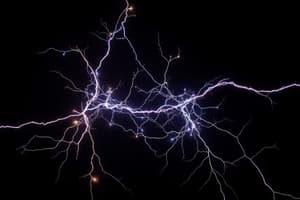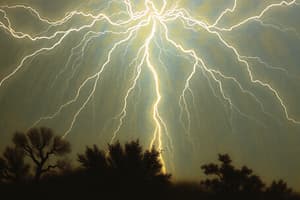Podcast
Questions and Answers
What is static electricity primarily characterized by?
What is static electricity primarily characterized by?
- Continuous flow of electric charge
- Resistance to electric flow
- Electrical potential difference
- Accumulation of electric charge (correct)
Which type of electricity flows in one direction?
Which type of electricity flows in one direction?
- Direct Current (correct)
- Static Electricity
- Current Electricity
- Alternating Current
What unit is used to measure voltage?
What unit is used to measure voltage?
- Watts
- Volts (correct)
- Ohms
- Amperes
According to Ohm's Law, if the voltage is 10 V and the resistance is 2 Ohms, what is the current?
According to Ohm's Law, if the voltage is 10 V and the resistance is 2 Ohms, what is the current?
Which of the following is NOT a power source for electricity?
Which of the following is NOT a power source for electricity?
What role does a switch play in an electric circuit?
What role does a switch play in an electric circuit?
Which of the following is an example of a renewable resource for electricity?
Which of the following is an example of a renewable resource for electricity?
What is the measure of opposition to the flow of current called?
What is the measure of opposition to the flow of current called?
Flashcards are hidden until you start studying
Study Notes
Definition of Electricity
- Form of energy resulting from the flow of electric charge.
- Commonly associated with electrons in motion.
Types of Electricity
-
Static Electricity
- Accumulation of electric charge on an object.
- Occurs due to friction, contact, or induction.
- Example: Lightning, static cling.
-
Current Electricity
- Flow of electric charge through a conductor.
- Measured in Amperes (A).
- Types:
- Direct Current (DC): Flows in one direction (e.g., batteries).
- Alternating Current (AC): Changes direction periodically (e.g., household power supply).
Key Concepts
- Voltage (V): The electric potential difference between two points; measured in Volts.
- Resistance (R): Opposition to the flow of current; measured in Ohms.
- Ohm's Law: V = I × R, where I is current in Amperes.
Components of Electric Circuits
- Power Source: Provides voltage (e.g., batteries, generators).
- Conductors: Materials that allow current to flow (e.g., copper wires).
- Load: Component that consumes electrical energy (e.g., light bulbs, motors).
- Switch: Controls the flow of current in the circuit.
Sources of Electricity
- Fossil Fuels: Coal, natural gas, oil.
- Renewable Resources: Solar, wind, hydroelectric, geothermal, biomass.
- Nuclear Energy: Fission of atomic nuclei produces significant energy.
Electrical Safety
- Use insulated tools and equipment.
- Avoid water exposure to electric devices.
- Always disconnect power before servicing electrical devices.
Applications of Electricity
- Residential: Lighting, heating, appliances.
- Industrial: Manufacturing, machinery, robotics.
- Transportation: Electric vehicles, trains, trams.
- Communication: Telephones, internet, broadcasting.
Basic Units of Measurement
- Voltage (V): Potential difference, measured in Volts.
- Current (I): Flow rate of electric charge, measured in Amperes.
- Resistance (R): Difficulty of current flow, measured in Ohms.
- Power (P): Rate of energy consumption, measured in Watts (P = V × I).
Definition of Electricity
- Electricity is a form of energy caused by the movement of electric charge, primarily involving electrons.
Types of Electricity
- Static Electricity:
- Results from the buildup of electric charge on surfaces due to friction, contact, or induction.
- Common examples include lightning and static cling.
- Current Electricity:
- Describes the continuous flow of electric charge through conductive materials.
- Measured in Amperes (A) with two main types:
- Direct Current (DC): Flows steadily in one direction, typical in batteries.
- Alternating Current (AC): Periodically changes direction, commonly used in household electricity supply.
Key Concepts
- Voltage (V): Represents the electric potential difference between two points, quantified in Volts.
- Resistance (R): Indicates opposition to current flow, measured in Ohms.
- Ohm's Law: Relates voltage, current, and resistance with the formula V = I × R.
Components of Electric Circuits
- Power Source: Supplies the necessary voltage to the circuit, such as batteries or generators.
- Conductors: Materials that facilitate the flow of current; copper is a common example.
- Load: Any device that consumes electrical energy, like light bulbs or electric motors.
- Switch: A device that regulates the flow of current within the circuit.
Sources of Electricity
- Fossil Fuels: Major sources include coal, natural gas, and oil, commonly used for electricity generation.
- Renewable Resources: Include solar, wind, hydroelectric, geothermal, and biomass sources, promoting sustainable energy.
- Nuclear Energy: Generated through the fission process of atomic nuclei, producing substantial energy outputs.
Electrical Safety
- Always use insulated tools to prevent electrical shocks.
- Keep electric devices away from water to avoid hazards.
- Disconnect power before servicing any electrical equipment to ensure safety.
Applications of Electricity
- Residential: Utilized for various purposes, including lighting, heating, and powering appliances.
- Industrial: Essential for manufacturing processes, machinery operation, and automation in robotics.
- Transportation: Powers electric vehicles, trains, and trams for efficient transit systems.
- Communication: Crucial for operating telephones, internet services, and broadcasting technologies.
Basic Units of Measurement
- Voltage (V): The unit measuring potential difference, expressed in Volts.
- Current (I): Indicates the rate of electric charge flow, measured in Amperes.
- Resistance (R): Describes how difficult it is for current to flow, expressed in Ohms.
- Power (P): Quantifies energy consumption rate, calculated as P = V × I and measured in Watts.
Studying That Suits You
Use AI to generate personalized quizzes and flashcards to suit your learning preferences.




